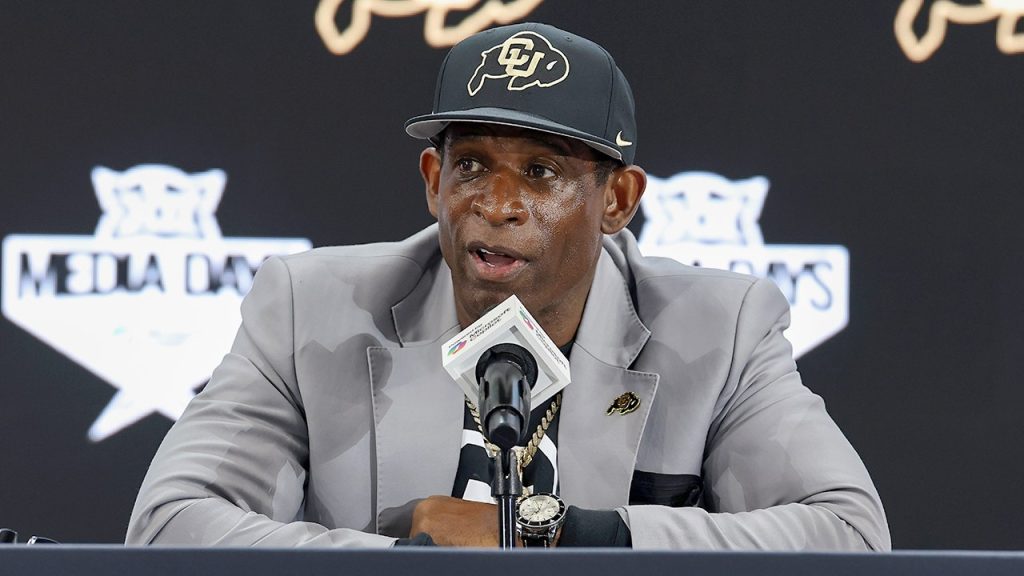Deion Sanders Advocates for Player Pay in College Football Playoff: A New Era of College Sports
In a refreshing and bold proposal, Colorado Buffaloes head coach Deion “Coach Prime” Sanders has suggested something revolutionary for the College Football Playoff (CFP) – actually paying the players who make it all possible. During an interview with The Associated Press alongside coaching legend Nick Saban, Sanders proposed a system where players would receive compensation for making the CFP, with additional bonuses for advancing through the tournament. “Now, it’s equality. Now, it’s even, and every player is making the same amount of money,” Sanders explained, drawing a parallel to the NFL’s playoff bonus structure, where Super Bowl winners each received $171,000 last year regardless of their role in the game. This concept represents a significant shift in thinking about college athletics, acknowledging the players as the true value creators in a multi-billion dollar industry that has traditionally restricted their compensation under the guise of amateurism.
The conversation between Sanders and Saban, which took place during the filming of their new Aflac commercial, highlighted the dramatic transformation college sports is undergoing in the Name, Image, and Likeness (NIL) era. Both coaching giants expressed concerns about the current unstructured approach to player compensation. Sanders candidly called many NIL deals “a joke,” noting that “there are only three or four guys who you might know their NIL, and the rest you’re just giving money to.” This statement underscores the arbitrary nature of the current system, where high-profile recruits can command lucrative deals while many other equally hardworking athletes receive comparatively little. The coaches’ discussion reflects the growing recognition that the current approach lacks fairness and transparency, with schools now having the ability to effectively make certain players millionaires through NIL arrangements, while universities can distribute up to $20.5 million to their athletes over the next year.
Saban, who recently retired after building one of college football’s greatest dynasties at Alabama, offered a more traditional perspective focused on long-term player development. “For years and years and years as coaches, and when we were players, we learned this: We’re trying to create value for our future,” Saban explained. “That’s why we’re going to college. It’s not just to see how much money we can make while we’re in college. It’s how that impacts your future as far as our ability to create value for ourselves.” This viewpoint represents the tension in modern college sports between immediate financial gain and the traditional educational mission of developing young athletes for life beyond sports. While Saban acknowledged the importance of fair compensation, his comments suggest concern that the pendulum may have swung too far toward commercialization at the expense of personal development.
When it comes to the structure of the CFP itself, Sanders specifically targeted the financial aspect, noting that conferences currently receive $4 million when their schools make the 12-team playoff, with additional money for wins. His proposal would redirect some of this wealth directly to the players who actually compete on the field. This approach would mirror professional sports leagues’ practice of sharing postseason revenue with players, rather than having it absorbed entirely by conferences and institutions. Such a system would acknowledge the reality that players are the primary attraction and revenue generators for college football’s premier events. Meanwhile, Saban weighed in on the controversial topic of guaranteed CFP bids for power conferences like the SEC and Big Ten, firmly rejecting the notion: “The NFC East has the Cowboys, Eagles and Giants. They have the biggest fan bases of anyone, and they have to play their way in. Everyone should play their way in.” His stance emphasizes competitive merit over market size or conference affiliation.
The evolving landscape of college athletics presents unprecedented challenges for coaches who must now navigate recruiting, team building, and program management in an environment where player compensation varies dramatically and transfer rules have been liberalized. For established programs like those Saban built, maintaining continuity and team chemistry becomes more difficult when players can easily transfer to other schools offering better financial opportunities. For rising programs like Sanders’ Colorado Buffaloes, the new rules create both opportunities to attract talent and challenges in retaining it. The discussions between these two coaching figures – one representing the established order and one representing a more disruptive approach – highlight the complex tensions in modern college sports as it increasingly resembles a professional model while still operating within educational institutions.
As college football continues its rapid transformation, the perspectives offered by Sanders and Saban provide valuable insight into how the sport might evolve to better serve both players and institutions. Sanders’ proposal for playoff compensation represents a pragmatic acknowledgment of players’ economic value, while Saban’s concerns about long-term player development remind us of the educational mission that theoretically underpins college athletics. What’s clear is that the old model of unpaid “student-athletes” generating billions in revenue for universities, conferences, and the NCAA is no longer sustainable or defensible. Whatever system emerges must balance fair compensation for players’ contributions with the educational and developmental aspects of college sports. The conversation between these two coaching icons reflects the sport’s struggle to find that balance in a rapidly changing landscape, where traditions are being challenged and new possibilities are emerging for how college athletics might operate in the future.


